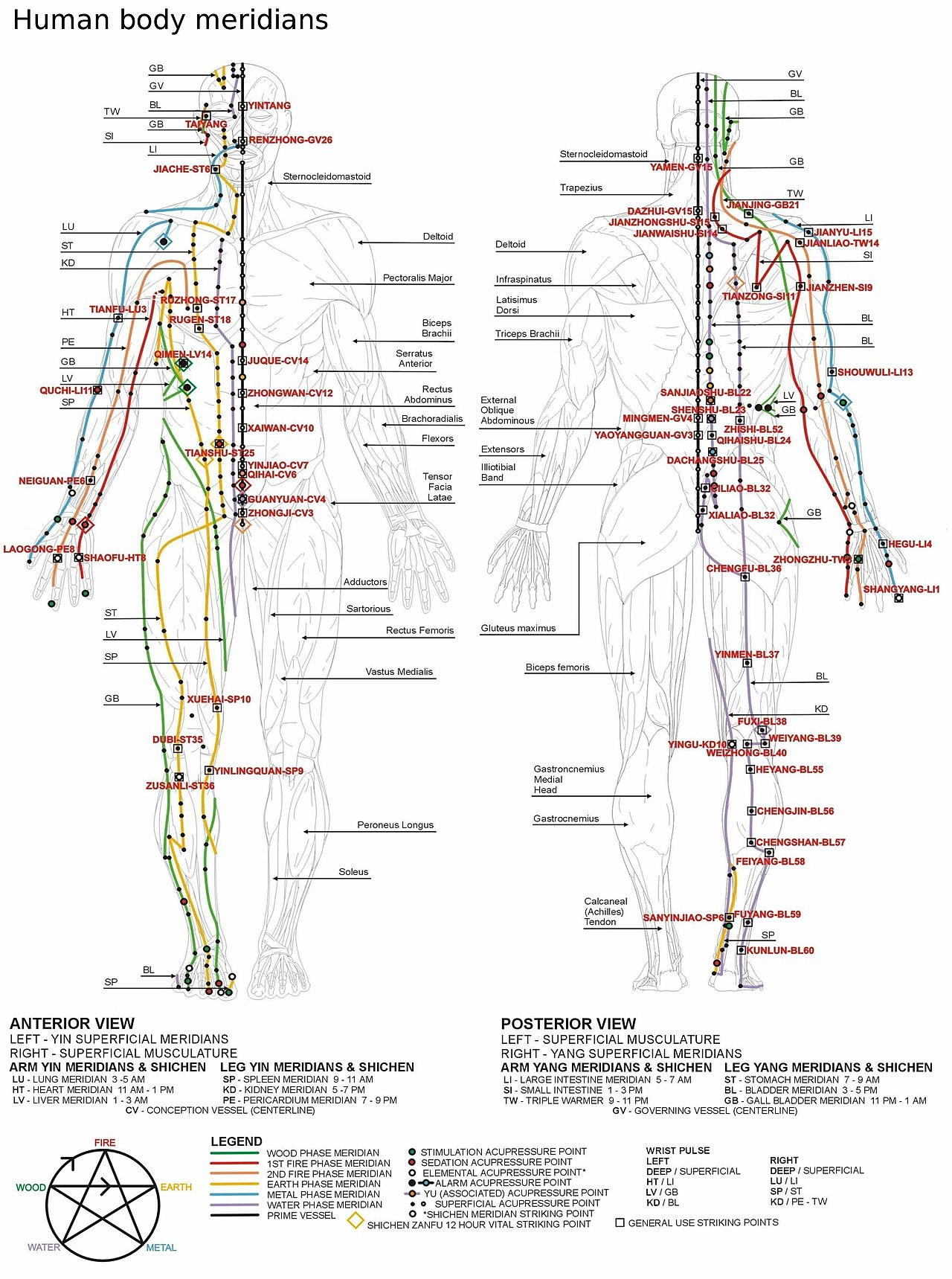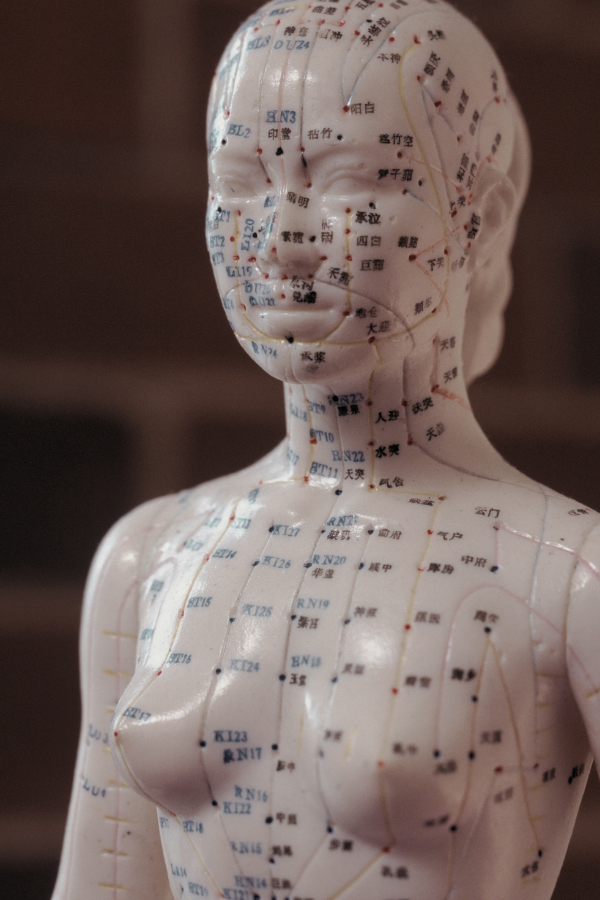

What is Meridian Theory, and How Does it Apply to Different Therapies?
Summary
Reflection Questions
Journal Prompt
Meridian Theory is a fundamental component of traditional Chinese medicine, proposing the existence of a network of energy pathways, known as meridians, throughout the human body. Originating from ancient Chinese culture, this theory suggests these pathways facilitate the flow of Qi, or vital energy, which is crucial for maintaining health and well-being. In contemporary health and wellness, Meridian Theory has gained recognition, particularly in fields like acupuncture and holistic medicine, for its approach to understanding and treating various health conditions by balancing the body’s energy flow. In this article, we will consider the part that the Meridian System plays in acupuncture, other traditional Chinese medicine (TCM) practices, and therapies like massage. Read on to learn more!
Historical Background
The inception of Meridian Theory is deeply embedded in ancient Chinese culture, evolving over centuries as part of the broader practice of traditional Chinese medicine. This theory was developed based on the understanding of the body as a complex system of energy flows, influenced by the natural and philosophical beliefs of the time. The concept of Qi, or life force, and its circulation through meridians, was integral to this ancient perspective on health and disease.
Historical Texts and Figures Who Contributed to Its Evolution
The evolution of Meridian Theory was significantly influenced by various historical texts and key figures. The most notable text is the “Huangdi Neijing” (The Yellow Emperor’s Classic of Medicine), which is considered a seminal work in traditional Chinese medicine.
It, along with contributions from medical scholars like Zhang Zhongjing, helped to codify and expand upon the ideas and practices surrounding Meridian Theory, shaping its application in medical treatments.
Fuel your creative fire & be a part of a supportive community that values how you love to live.
subscribe to our newsletter
Comparison with Western Medical Practices of the Time
Comparatively, Western medical practices during the era of Meridian Theory’s development were largely based on anatomical and physiological understandings of the human body, as influenced by Greek and Roman thought.
This Western medicine approach, focusing on tangible bodily structures and functions, stood in contrast to the energy-centric and holistic perspective of Meridian Theory, which emphasized the intangible flow of Qi and its balancing for health and wellness.
Fundamental Concepts of Meridian Theory


Qi, in the context of Meridian Theory, refers to the vital energy or life force that circulates throughout the body. Central to traditional Chinese medicine, Qi is considered the driving force behind all living functions and is essential for maintaining health and vitality.
It is believed that a balanced and unimpeded flow of Qi is crucial for physical, emotional, and mental well-being, while disruptions or imbalances in Qi flow can lead to illness.
Overview of the Meridian System
The meridian system in Meridian Theory comprises a network of pathways through which Qi flows. These pathways are classified into twelve primary meridians, each corresponding to major organs and systems in the body.
The meridians are often grouped into Yin and Yang categories, based on traditional Chinese philosophical concepts. Yin meridians include the Lung, Heart, Pericardium, Spleen, Kidney, and Liver. Yang meridians include the Large Intestine, Stomach, Small Intestine, Bladder, Triple Burner, and Gallbladder.
Each meridian not only connects to a specific organ but also influences certain bodily functions and health aspects, forming an integral part of the body’s holistic balance.
Twelve Major Meridians and Their Functions
The twelve primary meridians in traditional Chinese medicine, also known as the principal meridians, are pathways through which Qi (vital energy) flows. Each meridian is associated with a specific organ system and plays a unique role in maintaining the body’s balance and health. Here’s a brief overview of these meridians and their functions.
Lung Meridian (LU): It controls the respiratory system, influences Qi and respiration, and is involved in the immune response. It also impacts the skin and sweat glands.
Large Intestine Meridian (LI): This meridian is responsible for absorption and transportation of water, and it plays a role in the balance of fluids in the body. It is also associated with the process of elimination.
Stomach Meridian (ST): Governing digestion and the distribution of nourishment from food, this meridian is crucial for gastrointestinal health.
Spleen Meridian (SP): It is central to the functions of digestion and blood production. The spleen meridian also influences the lymphatic system and the metabolism of fluids.
Heart Meridian (HT): This meridian influences cardiac function and is also associated with emotional and mental states, particularly joy and love.
Small Intestine Meridian (SI): It is involved in digestion, absorption, and the separation of pure from impure substances within the body.
Bladder Meridian (BL): Governs the storage and excretion of urine and is involved in regulating water metabolism.
Kidney Meridian (KI): This meridian is essential for reproductive and developmental functions, influences the health of the bones and marrow, and is considered a source of vitality and longevity.
Pericardium Meridian (PC): Also known as the ‘Heart Conduit,’ it protects the heart and regulates its interactions with other organs. It is also involved in emotional balance.
Triple Burner Meridian (TB, sometimes called San Jiao): This meridian regulates the balance and distribution of fluids throughout the body and is involved in the function of the three ‘burners’ (upper, middle, and lower) which represent different areas of the body.
Gallbladder Meridian (GB): It is involved in the secretion and storage of bile, impacting digestion. The gallbladder meridian also influences decision-making and courage.
Liver Meridian (LV): This meridian regulates the flow of Qi and blood in the body, stores blood, and is involved in the health of the eyes and tendons. It also has a strong influence on emotional and mental states, particularly anger and stress.
Each of these meridians plays a specific and integral role in the functioning of the body’s systems, according to traditional Chinese medical theory. The balance and flow of Qi in these meridians are considered crucial for maintaining overall health and well-being.
The Relationship Between Meridians and Bodily Organs
In Meridian Theory, there is a profound interconnection between meridians and bodily organs. Each meridian is associated with an organ, and the health of that organ is believed to be directly influenced by the flow of Qi within its corresponding meridian.
This relationship is bidirectional; not only does the state of the Qi affect organ health, but the condition of the organ can also impact the flow and balance of Qi. This interconnectedness forms the basis for diagnosing and treating illnesses in traditional Chinese medicine, where the aim is to harmonize the flow of Qi in meridians and thereby improve organ function.
Meridians and Acupuncture


In acupuncture, meridians are targeted through the insertion of fine needles into specific points along these pathways. These points, known as acupuncture points, are strategically located where Qi is believed to be accessible and can be manipulated.
By stimulating these Meridian points, acupuncture aims to restore the balance and flow of Qi in the body, which is essential for health and well-being. This practice is based on the principle that proper energy flow along the meridians can prevent, alleviate, or cure diseases and medical conditions.
Theoretical Basis for Acupuncture Points Along the Meridian Lines
The theoretical basis for the selection of acupuncture points along the meridian lines is deeply rooted in traditional Chinese medicine. Each point is thought to have a specific effect on the Qi flow within its corresponding meridian and, consequently, on the health of the associated organ system.
The choice of points is guided by the theory that certain points have the ability to influence specific bodily functions, address imbalances, and correct disruptions in the flow of Qi. This practice is tailored to the individual’s specific health condition, aiming to target the root cause of the problem rather than just treating symptoms.
Clinical Examples
Clinical examples and case studies in acupuncture research often demonstrate the effectiveness of targeting meridians in treating various conditions. For instance, acupuncture has been found beneficial in managing chronic pain conditions, such as lower back pain and headaches. These points, when stimulated along the relevant meridians, function to reduce pain and inflammation.
Another example includes the treatment of digestive disorders through the manipulation of points along the stomach and spleen meridians, aiming to enhance digestive function and energy flow. These cases, backed by clinical research, showcase the potential of acupuncture as a complementary therapy in modern healthcare.
Meridian Theory in Acupressure and Cupping Therapy


In acupressure, Meridian Theory is applied by applying pressure to specific acupuncture points along the meridian pathways. This is done to regulate the flow of Qi, alleviate blockages, and bring balance to the body’s energy system, aiming to improve health and alleviate various conditions.
Cupping therapy, on the other hand, involves placing cups on the skin to create suction. This practice is believed to stimulate the flow of Qi and blood in the areas where the cups are placed, which often correspond to acupuncture points or meridians.
Both acupressure and cupping are used to address a range of issues, including pain, stress, and digestive problems, based on the principles of Meridian Theory.
Application of Meridian Theory in Massage Therapy


Massage therapy, while not directly based on Meridian Theory, can indirectly relate to it. Some massage techniques, especially those influenced by Eastern practices, may focus on pathways similar to meridians, aiming to improve energy flow and balance within the body.
Techniques like Shiatsu, a form of Japanese massage, explicitly use principles similar to Meridian Theory, applying pressure along these pathways to influence the flow of Qi. However, most Western massage techniques focus more on muscle, tissue, and joint health, without directly addressing the meridian system.
Meridian Theory in Modern Medicine
Recent research into Meridian Theory has explored its efficacy and underlying mechanisms, with several studies shedding light on its potential benefits and biological basis. For instance, a study published in the “Journal of Acupuncture and Meridian Studies” examined the physiological responses triggered by acupuncture, suggesting that stimulation of acupoints along meridians can influence the nervous system and endocrine functions.
Another significant piece of research, featured in “Evidence-Based Complementary and Alternative Medicine,” explored the impact of meridian-based therapies on pain management, indicating positive outcomes in chronic pain patients. These studies, among others, contribute to a growing body of scientific work attempting to understand and validate the principles of Meridian Theory within the context of modern medicine.
Recent research has largely focused on its effects on the autonomic nervous system. A study published on PubMed and in Frontiers in Neuroscience examined the impact of acupuncture on this system, suggesting that acupuncture can effectively alleviate symptoms associated with autonomic nervous system dysfunction, such as migraine, depression, and insomnia.
The study highlighted that acupuncture stimulation activates sensory nerve fibers and various brain regions, which then modulate the autonomic nervous system, potentially restoring homeostasis and relieving pain.
Integration of Meridian Theory in Modern Holistic Health Practices


Meridian Theory has been increasingly integrated into modern holistic health practices, often complementing conventional medical treatments. Practices such as acupuncture, acupressure, and Qi Gong, which are based on the principles of Meridian Theory, are now commonly used in various therapeutic contexts.
These approaches are particularly prevalent in pain management, stress reduction, and enhancing overall well-being. Many integrative medicine programs in hospitals and health centers now include these practices, recognizing their potential benefits in patient care and recovery.
Debates and Challenges in the Scientific Community
Despite growing interest and integration, Meridian Theory continues to be a subject of debate and challenge within the scientific community. One major point of contention is the lack of a clear anatomical or physiological basis for the existence of meridians and Qi, as defined in traditional Chinese medicine.
Skeptics argue that without empirical evidence supporting these concepts, their validity remains questionable. Furthermore, the inconsistency in research methodologies and the placebo effect in acupuncture studies have also been topics of discussion. These debates underscore the challenges in reconciling traditional theories with modern scientific paradigms and highlight the need for further rigorous research in this field.
Applications Beyond Medicine
In martial arts and energy practices such as Qi Gong and Tai Chi, Meridian Theory plays a significant role. These disciplines focus on the cultivation, balance, and flow of Qi through specific movements and postures.
Practitioners of these arts often use their understanding of meridians to enhance strength, flexibility, and vitality, as well as to achieve a deeper sense of mental and physical harmony. The movements in Tai Chi and Qi Gong are designed to stimulate and balance the flow of Qi along the meridians, which is believed to enhance health and increase longevity.
Its Influence in Other Holistic Approaches Such as Diet, Meditation, and Yoga
Meridian Theory also influences other holistic approaches, including diet, meditation, and yoga. In dietary practices, foods are often selected and combined based on their ability to influence the flow of Qi in specific meridians, thus contributing to overall health and balance.
In meditation and yoga, techniques that focus on breath control and body postures are employed to regulate Qi flow, with the understanding that a balanced Qi can lead to improved mental and physical well-being. These practices reflect the holistic nature of Meridian Theory, emphasizing the interconnection between mind, body, and energy.
Final Thoughts on Meridian Theory


Meridian Theory offers a unique perspective on health and wellness, emphasizing the flow and balance of Qi, or vital energy, through the body’s meridians. Its integration into practices like acupuncture has demonstrated potential benefits in modern healthcare, particularly in pain management and stressrelief.
Beyond medicine, its principles extend to martial arts, dietary practices, and mind-body disciplines like Tai Chi and yoga, underscoring its holistic approach to well-being. While debates continue in the scientific community regarding its empirical basis, Meridian Theory remains a significant and influential component within alternative and complementary therapies, reflecting a growing interest in integrating traditional wisdom with contemporary healthcare practices.








